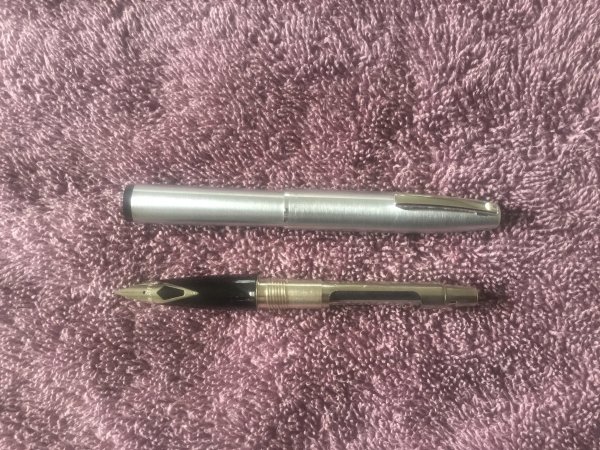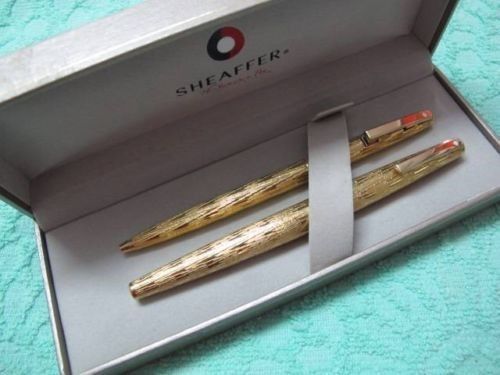Search the Community
Showing results for tags 'sheaffer imperial'.
-
Hi All, I have a dark blue Sheaffer Imperial Touchdown FP with a 14 k inlaid nib and gold cap ('SHEAFFER 14K USA' is imprinted on the nib, and only 'SHEAFFER' is imprinted on the cap and barrel). I am not a Sheaffer expert. Please help me identify my model. Photos attached. Thank you!
- 1 reply
-
- sheaffer imperial
- sheaffer touchdown
-
(and 1 more)
Tagged with:
-

Sheaffer Triumph 444 Brushed Chrome CT SS nib, showing original squeeze converter and modern piston converter.jpeg
Mercian posted a gallery image in FPN Image Albums
From the album: Mercian’s pens
A photo of my Sheaffer Triumph 444 Brushed Chrome pen with CT & Stainless Steel nib, with the squeeze converter that came to me with the (1980s?) pen, and the (2020s?) piston converter that I bought to use in it. The listing from which I bought this pen described it as an ‘Imperial’, but I believe that Sheaffer sold it as a ‘Triumph’ (having stopped selling the ‘high-end’ ‘Imperial’ models in the period during which this, lower-priced, model was still being sold). I was initially worried that the length of the piston-turning knob on the converter might mean that it doesn’t fit inside the barrel of the pen, but I can - happily - confirm that it fits deeply-enough into the grip-section that the barrel can fully screw-on to the pen 😊 I am impressed by how securely each converter is held by the grip-section.© Mercian
- 0 B
- x
-
- sheaffer
- sheaffer triumph
- (and 4 more)
-

Sheaffer Triumph 444 Brushed Chrome CT SS nib, showing squeeze converter.jpeg
Mercian posted a gallery image in FPN Image Albums
From the album: Mercian’s pens
A photo of my Sheaffer Triumph 444 - the model in Brushed Chrome finish with Chrome Trim and a Stainless Steel nib. It was listed as an ‘Imperial’, but I believe that Sheaffer sold it as a ‘Triumph 444’. I think that my example of this pen dates to the 1980s (rather than the 1970s), because of the ‘small diamond’/‘small kite’ shape of the ‘frame’ area of the inlaid nib, and because of the box and (undated) instruction leaflet with which the pen came to me. I know that it isn’t a ‘2444’ from the 1990s, because there is engraving/stamping around the base of the clip. I am impressed by how securely the squeeze converter fits in to the pen’s grip-section 😊© Mercian
- 0 B
- x
-
- sheaffer
- sheaffer triumph 444
-
(and 2 more)
Tagged with:
-
The Parker 75 “Cisele” & Sheaffer Silver Imperial
SimiaeParvus posted a topic in Fountain Pen Reviews
The Parker 75 “Cisele” & Sheaffer Silver Imperial After a few years in the hobby of collecting fountain pens I’ve reached a point, where my acquisition of pens gravitates towards a preferred style of pens. After some deliberation, I´ve come to the long term goal of acquiring a pen in sterling silver from each the “Big Four” American companies: Parker, Sheaffer, (Wahl-) Eversharp and Waterman. I´m currently halfway to that objective, having hunted down a Parker 75 in the “Cisele” (or “Cicelé”) pattern and a Sheaffer Silver Imperial in a diamond pattern. There’s no doubt that both represent the top-of-the-line in terms of design and materials. Aesthetically, they both share similar characteristics, being sterling silver pens sporting gold trim and a distinctive pattern engraved into the body of the pen. The Parker 75, released in the early 1960´s was a hit on the market. Since the ballpoints increase popularity and the eventual decline of the fountain pen, the purpose of the 75 was to be one of revival and prestige. The pen was aesthetically innovative attempt to catch the higher end. Earlier, Parker had tried to appeal to the broader market with pens such as the 21, 41 and 45 which was in the low end range.The 75 borrows design elements several other lines of Parkers pens. The idea of an adjustable nib had been tossed around since 1962 VP´s user-adjustable nib and the cartridge-converter was borrowed from the Parker "45". The Parker 75 Sterling Cisele hit the market in 1964, although being finished in 1963 for Parkers 75th anniversary. Decades later, the design is still as eye catching as when it was released and the quality shines through. It follows the basic design of the 75, which haven´t changed in decades. It´s a classy, conservative design that has aged well. Where it differs, is that the body of the pen is made of sterling silver, with a grid pattern. The body of the pen is rather slim, tapering from 11mm to 8mm. The cap is a “slip-on” which is solidly seated and post well. Because of it´s size and weight, posting is probably needed. The clip is simple but very distinctive and the details are simply beautiful. The tassies at either end is applied and is most likely gold plated. The black plastic section has a triangle-shaped grip and the nib can be rotated to different angles. That helps users which grip tend to rotate the pen. The upper part of the of the section, has several indices designating how much the nib is rotated. On earlier versions a “0” marked the center, but that was discontinued in 1968. Lacking that, this is probably made post-1968, just a few years before the introduction of the Sheaffer Silver Imperial. The nib is It writes really well, though it´s slightly dry and runs a nib gauge finer than the designated medium. The filling system is the simple and reliable cartridge-converter system. This system has been covered extensively elsewhere, so I won´t go over it here. Sheaffer did what any competitor would do. After the success of the Parker 75 they attempted to gain some of the market share, a few years later. The pen follows the design of the Imperial series, but instead of the typical it´s sterling silver in a lively diamond pattern. The pen is a classical, robust cigar shape with flat tops. It transitions with a slight taper from 12mm at the center of the barrel to 9 mm at either end. The body of the pen, is unibody with no particular step down from the cap. particularly the tapering section reminiscent to the Parker “51”. The shape of the body/section allow a variety of grips, which allows best writing angle for a wider group of users. The cap is a slip-on (“snap-cap”) is held on by friction. To keep it in place, there is three small tabs on the section, just between the section and barrel. It stays in place quite well, but doesn´t quite “click”. It can be posted, but I would not recommend it, as it throws off the balance and mar the finish. The gold filled clip has the white dot, indicating the lifetime guarantee. The clip is rather flat in colour, and seems slightly out of place. It is also is quite stiff. It seems poorly attached to the cap, so if you play with the clip a lot, be aware that it might snap off entirely with little to no force. The Touchdown filling system was introduced by Sheaffer in 1949, and is quite unique. It utilizes pneumatic air pressure created by down stroke of a cylindrical plunger to compress the sac inside the cylinder and fill the pen. For a proper fill, the entire nib and section must be immersed in the ink. Albeit for its innovativeness the Touchdown takes some getting used to, at it is slightly finicky. The system is quick to fill once you have the hang of it, but very slow to clean out. If you are a serial ink sampler, this might become slightly infuriating. But, if you like me, stick to the same inks it won´t be a problem if you stick to the same ink and the occasional maintenance cleaning. According to the sources, the pen is also available as a cartridge-converter, which should solve this disadvantage. Then there is Sheaffers infamous inlaid nib, unique to Sheaffer. Aesthetically, the design compliments the diamond pattern of the body quite well and is certainly anything but traditional. I suspect, although this is unfounded (I have done no work on this particular style of nib), that adjusting the nib shouldn´t be much trouble compared to a “standard-shaped” nib. Replacing it would another case though! The nib is where this pen really shines though: It´s a smooth experience with a slight bounce to it and the ink flow is almost perfect. Because of its wet nature, it runs slightly wider than the designated medium, bordering on a broad. In comparison, the 75 and Imperial are, albeit their similar aesthetics, quite different animals. Both pens have looks and the weight is pleasantly substantial because of the materials used, but where the 75 is slender and conservatively elegant, the Silver Imperial is slightly more hefty and bolder/flamboyant in its expression. In terms of construction, the Parker comes out slightly ahead, as the clip doesn´t seem as brittle and the Cartridge-Converter is more reliable in terms of use, maintenance and longevity. I´m aware that Silver Imperial is available in an C/C-incarnation, which nullifies this disadvantage. The diminutive size of the 75 and the forced tripod grip is too narrow for writing for more than a few minutes at a time before my hands cramp. The outcome is, a matter of preference. The Parker 75 isn´t quite as finicky or high maintenance as the Silver Imperial but the narrow, triangular grip is a minor but deciding gripe (No pun intended) for me although the adjustable nib angle a clear advantage as I have a tendency to rotate the pen. Parker 75 “Cisele”/ “Cicelé”, USA Production period: 1964-1966 Material: Sterling Silver in a crosshatch, cisele pattern Nib: 14k Medium Filling System: Cartridge-Converter Appointments: Gold Plated Length (Capped): 133mm Length (Uncapped): 122 mm Section Diameter: 9 mm Barrel Max Diameter: 11 mm Cap Max Diameter: 11 mm Weight, Uncapped (with ink and/or converter): 15 g Weight, Capped (with ink and/or converter): 24g Sheaffer Silver Imperial, USA Production period: 1970-197 Material: Sterling Silver in a crosshatch, diamond pattern. Nib: 14k Medium Filling System: Touchdown Appointments: Gold filled Length (Capped): 142 mm Length (Uncapped): 124 mm Section Diameter: 11 mm Barrel Max Diameter: 12 mm Cap Max Diameter: 12 mm Weight, Uncapped (with ink and/or converter): 18 g Weight, Capped (with ink and/or converter): 27 g Sources: Fischier. ”Parker 75”. www.Parkerpens.net. Web. 18.08-2018. <https://parkerpens.net/parker75.html> Mamoulides. “Sheaffer Touchdown Filling System”. www.Penhero.com. Web. 18.08-2018. <http://www.penhero.com/PenGallery/Sheaffer/SheafferTouchdownGuide.htm> Thomas. ”The Sheaffer Imperial Family of Fountain Pens”. www.Sheaffertarga.com. Web. 18.08-2018 <http://www.sheaffertarga.com/imperial%20and%20triumph/imperial%20write%20up.html> Wong. “FAQ”. www.Parker75.com. Web. 18.08-2018. <http://www.parker75.com/FAQ/FAQ.htm>- 8 replies
-
- parker 75 “cisele”
- sheaffer silver imperial
- (and 4 more)
-
I am interesting in old Sheaffer Imperial. The NOS pen from Peyton Street Pens (via eBay) cost around $65 include shipping to Thailand. My question is which Sheaffer Imperial should I get between the Imperial 330, Imperial 440 and Imperial II Touchdown?
-
I live in Delhi, India and i happened to visit stationery stores nearby who stores a huge range of fountain pens. He also has a good collection of used pens at a reasonable price. I'm so happy and excited about today's purchase which include 1) Sheaffer imperial - Rs.1200- approx $18 2) Sheaffer Prelude-Rs.1600- approx $24 3) cross pen with gold nib-Rs.4000- approx-$60 I couldnt identify the cross model, though its written "1/20 10KT Gold filled" in its cap.
- 6 replies
-
- cross
- sheaffer imperial
-
(and 1 more)
Tagged with:
-
-

Advice Needed - Vp Or Imperial Triumph?
CharlieTurtle posted a topic in Fountain & Dip Pens - First Stop
Okay, so I was outbid on the Sheaffer I was going to get (damn ) and started looking around, and I noticed that a lot of the time, hooded nibs are recommended as an alternative to inlaid/inset nibs. With brings me to my actual question: which is better for me, a Sheaffer Imperial Triumph or a Vanishing Point? The criteria I have: The pen would be used for taking lecture notes, and I can refill every day if necessary. I usually carry my pens clipped to the folder I'm using, or tucked inside if the clip doesn't allow it (looking at you, Parker Vector) The pen needs to be blue (I know, this has no effect on the performance, but I'm OCD and it has to match!) I like a fine to medium nib.The gold nib on the VP interests me because it's a little different, and considering that people have said inlaid nibs can be difficult sometimes, I'm cautious, as I have no skill whatsoever at tweaking pens. So, what do you think? PS if I do get a Vanishing Point is it worth having it tweaked by Mr Binder first?

.thumb.jpg.56805880cdbbe3ef2adf016aa113d3b0.jpg)














